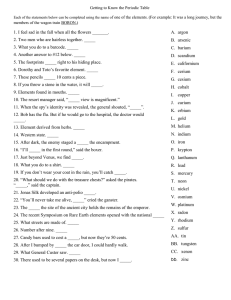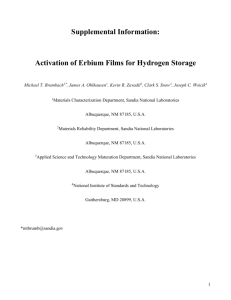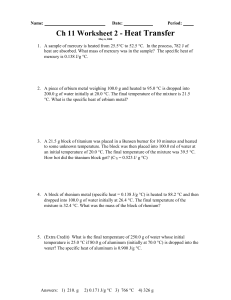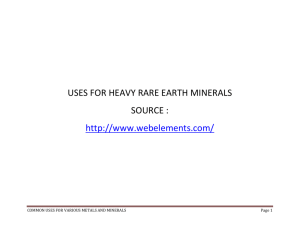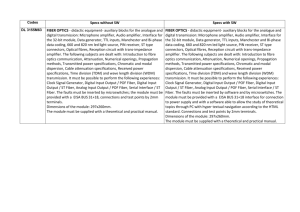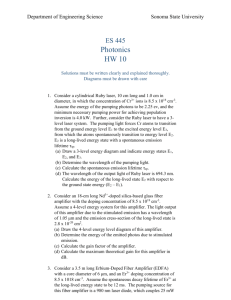Research Journal of Applied Sciences, Engineering and Technology 7(15): 3164-3170,... ISSN: 2040-7459; e-ISSN: 2040-7467
advertisement
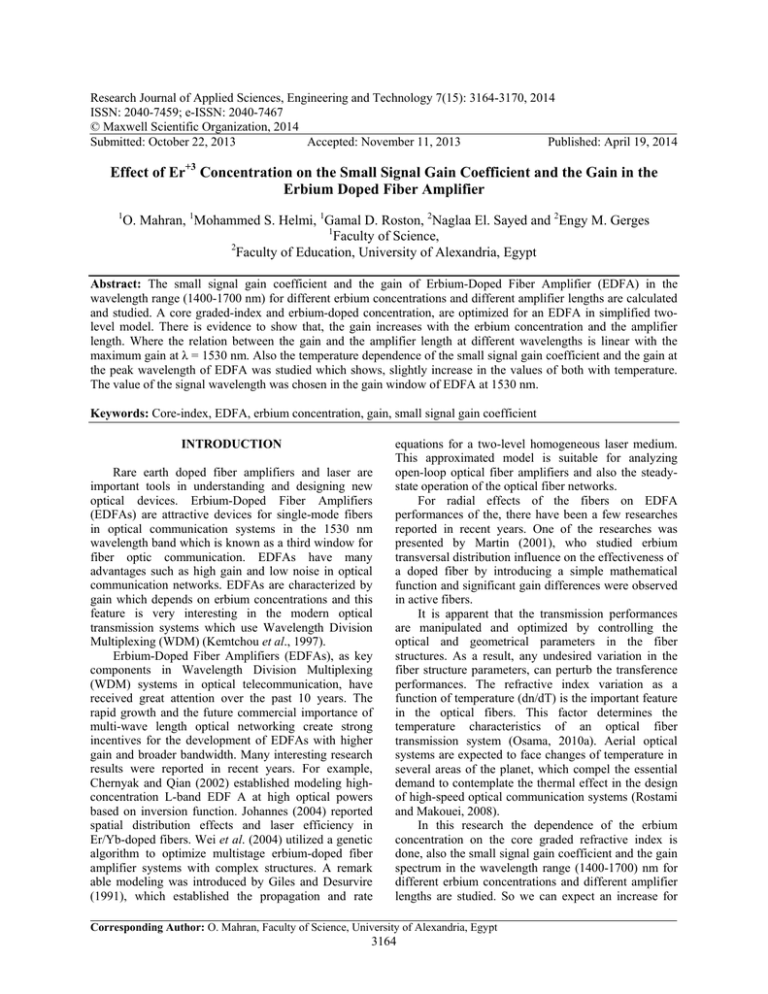
Research Journal of Applied Sciences, Engineering and Technology 7(15): 3164-3170, 2014
ISSN: 2040-7459; e-ISSN: 2040-7467
© Maxwell Scientific Organization, 2014
Submitted: October 22, 2013
Accepted: November 11, 2013
Published: April 19, 2014
Effect of Er+3 Concentration on the Small Signal Gain Coefficient and the Gain in the
Erbium Doped Fiber Amplifier
1
O. Mahran, 1Mohammed S. Helmi, 1Gamal D. Roston, 2Naglaa El. Sayed and 2Engy M. Gerges
1
Faculty of Science,
2
Faculty of Education, University of Alexandria, Egypt
Abstract: The small signal gain coefficient and the gain of Erbium-Doped Fiber Amplifier (EDFA) in the
wavelength range (1400-1700 nm) for different erbium concentrations and different amplifier lengths are calculated
and studied. A core graded-index and erbium-doped concentration, are optimized for an EDFA in simplified twolevel model. There is evidence to show that, the gain increases with the erbium concentration and the amplifier
length. Where the relation between the gain and the amplifier length at different wavelengths is linear with the
maximum gain at λ = 1530 nm. Also the temperature dependence of the small signal gain coefficient and the gain at
the peak wavelength of EDFA was studied which shows, slightly increase in the values of both with temperature.
The value of the signal wavelength was chosen in the gain window of EDFA at 1530 nm.
Keywords: Core-index, EDFA, erbium concentration, gain, small signal gain coefficient
INTRODUCTION
Rare earth doped fiber amplifiers and laser are
important tools in understanding and designing new
optical devices. Erbium-Doped Fiber Amplifiers
(EDFAs) are attractive devices for single-mode fibers
in optical communication systems in the 1530 nm
wavelength band which is known as a third window for
fiber optic communication. EDFAs have many
advantages such as high gain and low noise in optical
communication networks. EDFAs are characterized by
gain which depends on erbium concentrations and this
feature is very interesting in the modern optical
transmission systems which use Wavelength Division
Multiplexing (WDM) (Kemtchou et al., 1997).
Erbium-Doped Fiber Amplifiers (EDFAs), as key
components in Wavelength Division Multiplexing
(WDM) systems in optical telecommunication, have
received great attention over the past 10 years. The
rapid growth and the future commercial importance of
multi-wave length optical networking create strong
incentives for the development of EDFAs with higher
gain and broader bandwidth. Many interesting research
results were reported in recent years. For example,
Chernyak and Qian (2002) established modeling highconcentration L-band EDF A at high optical powers
based on inversion function. Johannes (2004) reported
spatial distribution effects and laser efficiency in
Er/Yb-doped fibers. Wei et al. (2004) utilized a genetic
algorithm to optimize multistage erbium-doped fiber
amplifier systems with complex structures. A remark
able modeling was introduced by Giles and Desurvire
(1991), which established the propagation and rate
equations for a two-level homogeneous laser medium.
This approximated model is suitable for analyzing
open-loop optical fiber amplifiers and also the steadystate operation of the optical fiber networks.
For radial effects of the fibers on EDFA
performances of the, there have been a few researches
reported in recent years. One of the researches was
presented by Martin (2001), who studied erbium
transversal distribution influence on the effectiveness of
a doped fiber by introducing a simple mathematical
function and significant gain differences were observed
in active fibers.
It is apparent that the transmission performances
are manipulated and optimized by controlling the
optical and geometrical parameters in the fiber
structures. As a result, any undesired variation in the
fiber structure parameters, can perturb the transference
performances. The refractive index variation as a
function of temperature (dn/dT) is the important feature
in the optical fibers. This factor determines the
temperature characteristics of an optical fiber
transmission system (Osama, 2010a). Aerial optical
systems are expected to face changes of temperature in
several areas of the planet, which compel the essential
demand to contemplate the thermal effect in the design
of high-speed optical communication systems (Rostami
and Makouei, 2008).
In this research the dependence of the erbium
concentration on the core graded refractive index is
done, also the small signal gain coefficient and the gain
spectrum in the wavelength range (1400-1700) nm for
different erbium concentrations and different amplifier
lengths are studied. So we can expect an increase for
Corresponding Author: O. Mahran, Faculty of Science, University of Alexandria, Egypt
3164
Res. J. App. Sci. Eng. Technol., 7(15): 3164-3170, 2014
the gain with the erbium concentration and the
amplifier length. Where the relation between the gain
and the amplifier length at different wavelengths is
linear with the maximum gain at λ = 1530 nm. Also the
temperature dependence of the small signal gain
coefficient and the gain at the peak wavelength of
EDFA was studied which shows, slightly increase in
the values of both with temperature. This is calculated
by theoretical model which made by the authors.
MATERIALS AND METHODS
Table 1: The optimized value s of β, δ, α, a and ∆n of the EDFAs
Central concentration
E ro (cm-3)
β (μm) δ
α
a (μm) ∆n
6.43×1019
2.6
2
0.108
4.1
0.0063
Table 2: Interpolated coefficient of the Eq. (8)
K (10-6)
J (10-6)
λ g (μm)
-1.6548
δ
− r (β, δ>0)
Er (r ) = Ero exp
β
(1)
where, E ro is the center concentration, β and δ are the
parameters required to be optimized in the genetic
algorithm. Equation (1) can show various radial profiles
with different values of β and δ. At r = 0, Er reaches a
maximum, which is coincident with actual erbiumdoped concentration.
For the fibers with radial distributions of the core
refractive index (i.e., graded-index fibers), some
parameters (e.g., cut-off frequency) describing light
propagation in a step-index are no longer available
since the graded-index alters with the core radius. Some
detail analyses on this aspect were already developed
and one of these is a usual variational method (Cheng
and Xiao, 2005), in which a graded-index is reduced
into an equivalent step-index. Here, a useful formula for
the core refractive index is given by Osama (2010a):
r (r≤a)
2
2
ncore
= nclad
1 + 2∆nH a
(2)
δ
1
2
α (5)
n
a
1
core
2 − 1
E r (ncore ) = E ro exp − 1 −
β 2∆n nclad
The values of a, ∆n, α, β and δ are chosen to
optimizing an Erbium-Doped Fiber Amplifier (EDFA),
(Osama, 2010b) and are given in Table 1.
The refractive index variation of the core due to
temperature and wavelength is considered in this
section. The method used in this study has been
introduced by Ghosh (Rostami and Makouei, 2008).
This model is based on the subscription of both
electrons and optical phonons. The optical constants
computed from this model are then used to calculate the
refractive indexes at any operating temperature or
wavelength for the optical fiber transmission system.
Thermo-optic coefficient dn core /dT contains the
contribution of electrons and optical phonons.
Consequently, it can be described in the optical
transmission range in terms of linear expansion
coefficient α t and the temperature variation of energy
gap (dE/dT) by the following relation as Osama
(2010b):
E g2
2 dE g
dn
2n core = χ e − 3α t −
.
. 2
2
dT
E
dT
E g − E
g
(
𝑅𝑅 =
2
1 ncore
2 − 1
r = 1 −
n
2
∆
n
clad
(3)
1
α
a
(4)
𝜆𝜆 2
𝜆𝜆 2 −𝜆𝜆 2𝑔𝑔
(Rostami and Makouei, 2008)
dn
2n core = KR + JR 2
dT
α
Then the core radius can give as:
)
(6)
where, χ e , E and E g are the electronic susceptibity,
photon energy and the suitable energy gap lying in the
vacuum ultraviolet region, respectively. Equation (6)
can be rewritten in terms of a normalized wavelength
as:
where, a is the fiber core radius and ∆n is the relative
refractive-index difference. The function H has the
following form Osama (2010b):
r
r
H = 1 − 0<α<∞
a
a
0.109
The relation between the erbium concentration and
the refractive index of the core can give by substituting
the value of r in Eq. (1), we can give:
This theoretical research of the dependence of the
erbium concentration on the core graded refractive
index is done.
Model: There are several functional forms that can be
chosen to describe the radial distribution of the erbium
ions. We use an exponential function as follows
(Osama, 2010a):
31.7794
α t (106
)
0.45
(7)
(8)
where, the constants K and J are related, respectively to
the thermal expansion coefficient (α t ) and the energy
gap temperature coefficient (dE g /dT) according to the
relations presented in Osama (2010a) and their values
are given in Table 2 for silica glasses (Osama, 2010b).
Integrating Eq. (8), we obtain:
3165
Res. J. App. Sci. Eng. Technol., 7(15): 3164-3170, 2014
(KR + JR )T + n
ncore =
(9)
2
o
where, n o is constant equal the value of 1.455
The relation between the erbium concentration and
the temperature can be obtained by substituting the
Eq. (9) in (5). This is given by:
a
1
Er (T ) = Ero exp − 1 −
β 2∆n
( (KR + JR )T + n ) − 1
2
2
o
2
clad
n
1
α
δ
(10)
The small signal gain coefficient (g) as a function
of erbium concentration E r (n core ) is given from Eq. (5)
and (9), with the optimized values of α, β, δ and the
relative inversion D = 1, which represents a complete
medium inversion (Cheng and Xiao, 2005):
g = Er (ncore )
{σ e (λk )(1 + D) − σ a (λk )(1 − D)}
2
Fig. 1: Profiles of the core refractive index
(11)
β (µm)
7
where, σ a (λ k ) and σ e (λ k ) are the absorption and
emission cross sections of the laser transition at λ k ,
respectively. The amplifier gain, G, can be calculated
as:
(
)
(12)
Equation (12) appears to suggest that the gain is a
complex function of the shape of the inversion along
the length of the fiber. In fact, the gain can be related
simply to the average inversion. Define an average
���2 and similarly for the lowerupper-state population 𝑁𝑁
state population ���
𝑁𝑁1 , which both are function of E r
(n core ) as Jander and Brockles (2004):
L
N2 =
1
N 2 ( z ) dz
L ∫0
N1 =
1
N1 ( z ) dz
L ∫0
(13)
L
(14)
Equation (12) can then be simplified to:
[(
) ]
G = exp N 2σ s(e ) − N1σ s(a ) Γs L
Er-concentration (x1019 cm-3)
G = exp ∫ N 2 ( z )σ s(e ) − N1 ( z )σ s(a ) Γs dz
0
L
(15)
This shows that, the signal gain after traversal of
the fiber is dependent only on the average inversion of
the erbium ions in the fiber and does not depend on the
details of the shape of the inversion as a function of
position along the fiber length.
RESULTS AND DISCUSSION
Table 1 lists some optimized results of the EDFA
(Osama, 2010b) and the required radial distribution of
β=0.2
β=1
6
β=2.6
β=4.2
5
β=5.8
β=7.4
4
β=9
β=13
3
β=19.4
2
1
0
-5
-4
-3
-2
-1
0
1
2
3
4
5
-1
Core radius, r (µm)
Fig. 2: Effect of β on Er-concentration
the core refractive index is shown in Fig. 1 which gives
a symmetrical behavior of the core refractive index in
both positive and negative sides of the core radius at
α = 0.108 (optimal value). The maximum value of
n core = 1.459 at which the erbium concentration are
concentrated on the axis while it is decreases on the
wings. For α>0.108, there is unsymmetrical behavior of
the core refractive index in both the positive and
negative parts.
Figure 2 shows the effect of the parameter β
(describing erbium radial distribution, as defined in
Eq. (1) on the erbium concentration and consequently
the gain bandwidth. Note that, the total erbium
concentration, i.e., the areas under the profiles, is
altered with various β values. As a comparison, we
adopt a uniform erbium concentration while keeping
the total concentration the same this with different
distribution of erbium ions. The maximum value of
erbium concentration is located at the axial core radius
where r = 0 and this value decrease on the two side
where the core radius increases. Figure 2 shows also
3166
Res. J. App. Sci. Eng. Technol., 7(15): 3164-3170, 2014
Er=5.348805E+24
7
Er=4.809868E+25
Er=6.268027E+25
gain coefficient, g (m-1)
6
Er=6.420053E+25
Er=6.429635E+25
5
Er=6.429994E+25
Er=6.43E+25
4
3
2
1
0
1450
1500
1550
1600
1650
wave length, λ (nm)
Fig. 5: Small signal gain coefficient of erbium doped
alumino-germanosilicate glass fiber amplifier at
different Er-concentration
Fig. 3: Effect of δ on Er-concentration
α =0.108, β =2.6, δ =2
6
5
4
3
2
1
0
1.45
1.452
1.454
1.456
1.458
1.46
Core refractive index, ncore
Fig. 4: The optimized values of α, β and δ on Er
concentration with the effect of core refractive index
that, the optimal value of β is 2.6 µm. This corresponds
to the optimal distribution curve. At this value of β the
distribution allows the signal to make total internal
reflection inside the fiber.
Figure 3 shows the effect of the parameter δ on the
erbium concentration profile. However, it is shown that
for some values of δ, the erbium concentration takes a
negative value which is not true. The optimal
distribution take place when δ = 2, which gives the
same effect on the erbium concentration profile on the
positive and negative sides of the core radius with
maximum value of the erbium concentration =
6.43×1019/cm3 on the axis. The optimized values of α, β
and δ of the EDFAs on the calculation of the erbium
concentration as a function the core refractive index
according to Eq. (5) is shown in Fig. 4.
Er=5.348805E+24
L=20 m
L=27 m
5.6
Er=5.348805E+24
8
Er=4.80986826E+25
Er=4.80986826E+25
Er=6.26802727E+25
4.8
Er=6.42963488E+25
Gain, G (dB)
4
Er=6.42999351E+25
Er=6.43E+25
3.2
2.4
Er=6.26802727E+25
7
Er=6.42005314E+25
Er=6.42005314E+25
Er=6.42963488E+25
6
Gain, G (dB)
19
-3
Er-concentration(x10 cm )
7
Er=6.42999351E+25
5
Er=6.43E+25
4
3
1.6
2
0.8
1
0
1400 1450 1500 1550 1600 1650 1700
0
1400 1450 1500 1550 1600 1650 1700
wave length, λ (nm)
wave length, λ (nm)
(a)
(b)
3167
Res. J. App. Sci. Eng. Technol., 7(15): 3164-3170, 2014
L=40 m
11.2
Er=5.348805E+24
L=50 m
Er=5.348805E+24
14
Er=4.80986826E+25
Er=4.80986826E+25
Er=6.26802727E+25
Er=6.26802727E+25
9.6
Er=6.42963488E+25
Er=6.42999351E+25
6.4
Er=6.43E+25
4.8
Er=6.42005314E+25
Er=6.42963488E+25
10
Gain, G (dB)
8
Gain, G (dB)
12
Er=6.42005314E+25
Er=6.42999351E+25
Er=6.43E+25
8
6
3.2
4
1.6
2
0
1400 1450 1500 1550 1600 1650 1700
0
1400 1450 1500 1550 1600 1650 1700
wave length, λ (nm)
wave length, λ (nm)
(c)
(d)
Fig. 6: Gain spectrums for erbium doped alumino-germanosilicate glass fiber amplifier, for different values of Er-concentration
at the labeled amplifier lengths as in a, b, c and d
λ (nm)
λ =1530 nm
λ=1500
14
6.416
λ=1510
gain coefficient, g (m-1)
λ=1520
12
λ=1530
λ=1540
Gain, G (dB)
10
λ=1550
λ=1560
8
λ=1570
λ=1580
6
λ=1590
λ=1600
4
2
6.415
6.414
6.413
6.412
6.411
6.41
6.409
6.417 6.418 6.419 6.420 6.421 6.422 6.423
0
10
20
30
40
Er-concentration (x1025 m-3)
50
Length, L (m)
(a)
Fig. 7: The maximum gain spectrum for erbium doped
alumino-germanosilicate glass fiber amplifier
7.522
7.521
Gain, G (dB)
The relation between the small signal gain
coefficients (g) m-1 and the wavelength (λ) nm around
the 1.5 μm laser transition of a typical Er+3 doped
alumino-germanosilicate glass fiber amplifier at
different values of erbium concentration, are illustrated
in Fig. 5. Notice that when the erbium concentration
increases the gain coefficient increases and show less
broadening. Also the maximum gain coefficient (peak)
at the wavelength 1530 nm, this peak is the reason for
choosing the erbium ions doped silica fibers to be the
most widely used devices, because they have a
transition in the third telecommunication window,
around 1530 nm.
The relation between the gain, G (dB), for erbium
doped alumino-germano-silicate glass fiber amplifier
and the wavelength with different values of the
amplifier lengths at different erbium concentration are
λ =1530 nm
7.523
7.52
7.519
7.518
7.517
7.516
7.515
6.417 6.418 6.419 6.420 6.421 6.422 6.423
Er-concentration (x1025 m-3)
(b)
Fig. 8: The effect of Er-concentration on the gain coefficient
and the gain at wavelength 1530 nm
3168
Res. J. App. Sci. Eng. Technol., 7(15): 3164-3170, 2014
signal wavelength 1530 nm, according to the Eq. (9),
(10) and (14). This show slightly increases in the values
of gain coefficient (g) m-1 and of Gain (G) dB with
Temperature (T) °C. The value of the signal wavelength
was chosen in the gain window of EDFA at λ = 1530
nm.
λ=1530 nm
6.416
gain coefficient, g (m-1)
6.415
6.414
6.413
6.412
CONCLUSION
6.411
Radial effects of the core graded-index and erbium
doped concentration are studied with the optimized
parameters values α, β and δ for an Erbium-Doped Fiber
Amplifier (EDFA) in a two-level model. Also the small
signal gain coefficient and the gain spectrum in the
wavelength range (1400-1700) nm for different erbium
concentrations and different amplifier lengths are
studied. There is evidence to show that, the gain
increases with the erbium concentration and the
amplifier length. Where the relation between the gain
and the amplifier length at different wavelengths is
linear with the maximum gain at λ = 1530 nm. Also the
temperature dependence of the small signal gain
coefficient and the gain at the peak wavelength of
EDFA was studied which shows, slightly increase in the
values of both with temperature. The value of the signal
wavelength was chosen in the gain window of EDFA at
1530 nm.
6.41
6.409
0
20
40
60
80
o
Temperature, T ( C)
(a)
λ=1530 nm
7.523
7.5218
Gain, G (dB)
7.5206
7.5194
7.5182
7.517
7.5158
7.5146
0
20
40
60
REFERENCES
80
Temperature, T (oC)
(b)
Fig. 9: The effect of temperature on the gain coefficient (a)
and the gain at constant wavelength 1530 nm (b)
studied using Eq. (14). Figure 6 shows such relation at
L = 20, 27, 40, 50 m in the range of the wavelength
from 1400 to 1700 nm. It is found that, as the erbium
concentration increases, the amplifier gain increases
and the curve show less broadening, the maximum gain
takes place at wavelength = 1530 nm.
The gain is also plotted with amplifier length at
different values of wavelength and at n core = 1.46. In
Fig. 7, the relation is found to be linear between the
gain and the length. This is clear from the relation of
(G, L). Also the maximum gain at wavelength = 1530
nm which is corresponding to the peak of the erbium
ions doped silica fibers.
The effect of erbium concentration on the gain
coefficient and the gain at the peak of the erbium ions
are calculated according to the Eq. (10) and (14) is
plotted in Fig. 8.
Figure 9 shows the temperature dependence of the
small signal gain coefficient and the gain at constant
Cheng, C. and M. Xiao, 2005. Optimization of an
erbium doped fiber amplifier with radial effects.
Opt. Commun., 254: 215-222.
Chernyak, V. and L. Qian, 2002. Modeling high
concentration L-band EDFA at high optical powers
based on inversion function. IEEE J. Sel. Top.
Quant., 8: 569.
Giles, C.R. and E. Desurvire, 1991. The propagation
and rate equations for a two-level homogeneous
laser medium. J. Lightwave Technol., 9: 271.
Jander, P. and W.S. Brockles, 2004. Spectroscopy of
yttria-alumina-silica glass doped with thulium and
erbium. IEEE J. Quantum Elect., 40: 509-512.
Johannes, K., 2004. Spatial distribution effects and
laser efficiency in Er/Yb-doped fibers. Proceeding
of the SPIE Conference on Optical Components
and Materials, 5350: 222.
Kemtchou, J., M. Duhamel and P. Lecoy, 1997. Gain
temperature-dependence of erbium-Doped silica
and fluoride fiber amplifiers in multichannel
wavelength-multiplexed
transmission-systems.
IEEE J. Lightwave Technol., 15(11): 2083.
Martin, J.C., 2001. Erbium transversal distribution
influence on the effectiveness of a doped fiber.
Opt. Commun., 194: 331.
3169
Res. J. App. Sci. Eng. Technol., 7(15): 3164-3170, 2014
Osama, M., 2010a. Study the effect of temperature on
the optimum length of Er3+ doped alminogermanosilicate, aluminum-oxide and yattriasilicate glass. Res. J. Appl. Sci. Eng. Technol.,
2(4): 381-386.
Osama, M., 2010b. Wavelength and temperature
dependence of the Er+3 concentration in the
erbium doped fiber amplifier. Res. J. Appl. Sci.
Eng. Technol., 2(4): 396-400.
Rostami, A. and S. Makouei, 2008. Temperature
dependence analysis of the chromatic dispersion in
wII-type zero-dispersion shifted fiber (zdsf). Prog.
Electromagn. Res. B, 7: 209-222.
Wei, H., Z. Tong, T. Li and S. Jian, 2004. Utilized a
genetic algorithm to optimize multistage erbiumdoped fiber amplifier systems with complex
structures. Opt. Exp., 12: 531.
3170
